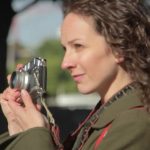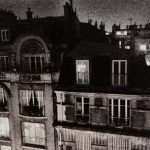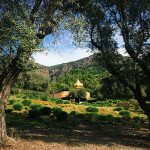“I perhaps owe having become a painter to flowers.” -Claude Monet
I perhaps owe having become a photographer to the essence of time. Time is my obsession, my fixation. Every moment is always on its way out, and the next one is always coming. What is it like to freeze time? Nostalgia perfects. Looking back, our minds sweeten what we want to cherish, downplay what we want to forget. So, an imperfect photo can be the most perfect reflection of a moment, in that it feels realistic.
It’s possible I isolate some people from appreciating my work because of this — not everyone is willing to take such a plain and candid look at themselves, even in hindsight. But time is what I care about. And, trying to find expression for a moment past. Oddly, this obsession has taught me how to feel the “swell” of a moment, to anticipate things lining up into a composition or an emotion, like a fortune teller, finding clues and latching onto them before anyone else realizes. That’s how I make my photos — I snatch them out of thin air. I feel the truth when it appears, and snap it up. Not everyone wants to know the truth. I know this. The truth can be scary and disparate from our self-image.
It can also catch in your throat as the most profoundly beautiful thing. Maybe not literally beautiful. That certain je-ne-sais-quoi that some people have and we admire across the restaurant. In my experience, everyone has the certain something inside, and it will come out, if I am patient, and the person is willing to be the subject of my camera’s gaze long enough.
“There is a creative fraction of a second when you are taking a picture. Your eye must see a composition or an expression that life itself offers you, and you must know with intuition when to click the camera. That is the moment the photographer is creative. Oop! The Moment! Once you miss it, it is gone forever.” -Henri Cartier-Bresson
I love this Cartier-Bresson quote. I have crafted my career, nay, my life, so that when I am being paid to tune into those creative fractions of seconds, I can do so. It requires letting go of everything else and tuning into the feeling of what’s before me. I have to take care of my health, my well-being, my everything, so that when I am meant to be in position to capture, that fraction of a second does not escape me.
Many photographers like to talk about technical things like advances in camera technology and software. They like to look for the latest thing to improve their images. There is certainly an artistry to creating a visually perfect image, to push technology to the limits of its capabilities, and create the most technically perfect image possible. I admire people’s anal retentiveness in achieving this. But that is simply not how I see the medium. I don’t see it as a tool through which to create a perfect past — photographs are always depictions of the past, as they are recorded moments that have already gone by. To retroactively or preemptively alter that seems somewhat bizarre, although it is simply a separate artistry, one for which others possess a passion I don’t.
My relationship with technology is very simple. I see it as a tool with which to endure my otherwise utterly baffling obsession with time. I take the apparatus before me, I learn them as well as I can, and quickly size up their capabilities and their shortcomings. In fact, it’s the shortcomings that fascinate me. I will knowingly push a camera past the limits of its shortcomings, into the realm of imperfection, where what it captures is flawed, blurred, “improperly” exposed. Life is full of imperfection, flaws, blurs, and improper exposure. To me, flawed images look like memories. In my mind’s eye, no memory is perfectly intact as a visual picture. Each has its own haze, a glow around it, a flash of something, a sense that it was slapped together, or that it came together perfectly but then quickly crumbled. And, for me, it is not always about looking back. It is about looking forward and planning so that I am in the best possible mindset to capture a moment, which includes a lot of trust in the creative process, my own whims, and of course, technical know-how.
It is a humbling and incredible fact that I have built a career out of this focus, my rabid need to record. When something strikes me, I not only feel its beauty and its truth, I also sense its death. I know as the moment swells into perfection, it is ending at the very same time. Some might call this constant awareness of things passing, “a curse.” I was fortunate enough to channel it into a desire to record, to capture, to make an artistic memory of. I actually have no idea whether my clients know this about me, or even notice it in the work. That’s what makes it such a honor to have clients at all — I am enabled to explore my obsession, and in the process I am doing something that people seem to like. I’m not entirely sure what it is, but I am so grateful that something I’m doing reaches people.
I think it’s beautiful when someone says something that seems to imply it reached them in that way, but it’s hard to ever know how someone else has truly felt about something. Yet, regardless, I cannot stop. It is the foundation for everything I do, whether it’s photographing, filming, recording sound, or writing. Truth is perfection, and truth seldom looks perfect — that’s the paradox I live with. It seeks expression in my work, and I hope that complicates my work in the best ways possible, but I have no idea if it does. Maybe to some people it just looks messy and like I don’t care about the details. But I do care about the details, so much that it hurts. I just know that how they look to my eye in real time is not the same as experiencing the whole of what the mind experiences when I see them. Unless I am seeing the thing in a sensory deprivation chamber, my ears and fingers and lips and nose and heart are having an experience, too, and perhaps the details look different through all of those lenses at once. I’m willing to trust that my relationship with the camera has opened to the point where I allow more than the object itself to flow in.
I don’t even know what happens to me when I’m photographing. I become a part of the moment. I feel like I disappear, and yet my subjects are looking at me. I have to think of things to say to reassure them that I am still there and that they are still there, and that everything is good. I don’t remember what I say. It’s different every time. Sometimes I wonder if I have made a fool of myself, but I stopped being concerned about that when I was quite a young photographer. If I concern myself with anything but the shot, even for a moment, I could miss my fraction of a second to be creative. So, perhaps some people think my work is imperfect, and perhaps I act rather like a fool when I am photographing, but I do it all so that when the moment arises, I can sense it coming and rise to meet it. It’s the only way to give a fighting chance to the creation of that visual memory. And, it’s really, really hard to nail it. There’s a huge failure rate in photography — most of the images taken are not “the” shot. Sometimes you only get close. And, sometimes close is just right.
Whether my clients all recognize it or not, this is what I am offering them: the very, very best of me in a unique moment in their lives. (It’s my duty not just to them, but to my obsession with time, and I’m relentless about it.) For those who question whether or not it is the best moment of them, I would say, give the photo 10-20 years. Then look back and see what it tells you; what truths it reveals, what hopes, what momentarily flaws, what evidence of how far you’ve come, and what proof of where you once stood. Photographs are miraculous things. When someone tells you to look for everyday miracles, look at a photograph and realize that it represents what was once a moment in time, and that someone figured out to how emulate your eye’s abilities and put that visual moment into a form where you could revisit it. We are bombarded today with more images than humans ever were before. Bombarded with miracles. If only we saw it that way.



